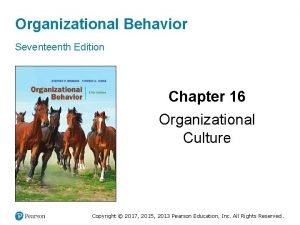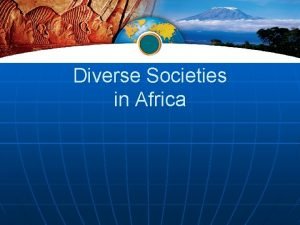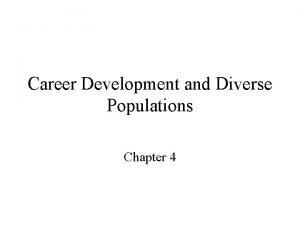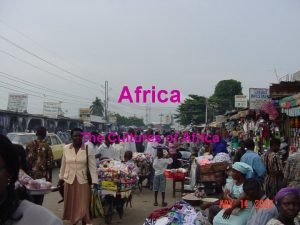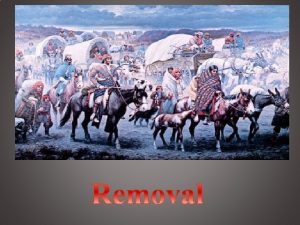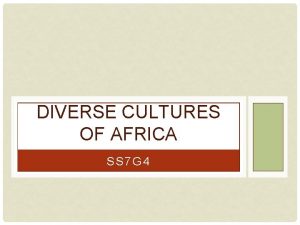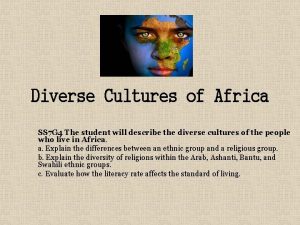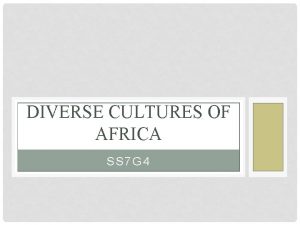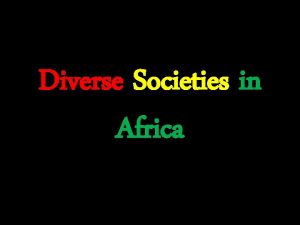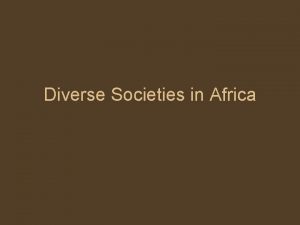Diverse Cultures of Africa SS 7 G 4













- Slides: 13

Diverse Cultures of Africa SS 7 G 4 The student will describe the diverse cultures of the people who live in Africa. a. Explain the differences between an ethnic group and a religious group. b. Explain the diversity of religions within the Arab, Ashanti, Bantu, and Swahili ethnic groups. c. Evaluate how the literacy rate affects the standard of living.

Ethnic group vs. religious group • An ethnic group is a group of people who share cultural ideas and beliefs that have been a part of their community for generations. The characteristics they may have in common include language, shared history, types of food, and a set of traditional stories, beliefs, or celebrations. • A religious group shares a belief system in a god or gods, with a specific set of rituals and a sacred text. People from different ethnic groups may share the same religion, though they may be from very different cultures.

Africa’s 4 Ethnic Groups (that we are studying) 1)Arab 2)Ashanti 3)Bantu 4)Swahili

Arab • Arab people began to spread into North Africa in the late 600 s • Wherever the Arabs went, they took the religion of Islam and the Arabic language with them • Arab traders traveled across the Sahara, to the Sahel, and beyond • The Arabic language, religion of Islam, and other aspects of Muslim culture became part of Africa

Many Arabs are found in Africa- they make up a majority of the people living along the Mediterranean coast and in some countries along the Indian Ocean

Ashanti • The Ashanti are found in the modern country of Ghana.

Ashanti • They believe that their kingdom was founded in 1701 with the help of a holy man who produced a Golden Stool from the heavens (This stool symbolizes their power) • Religions – The traditional religion is centered on a belief in a supreme god, or Nayme. – Others religions practiced by the Ashanti include Christianity and Islam.

Bantu • The Bantu-speaking people of Africa migrated in many waves from the region just south of the Sahara to the central and southern parts of Africa over 2, 000 years ago • Settled as far south as the southern tip of Africa • The Bantu migration was one of the largest movements of people in Africa’s history • Today, the speakers include many different ethnic groups (hundreds of related languages) • Over 60 million people in central and southern Africa speak Bantubased languages and share some part of Bantu culture

• Religion Bantu – Traditional religions • Animists believe spirits are found in natural objects and surroundings – Some are Christian, and some are Muslim – Religion is based on where they are located (dominant religion of where they are located)

Bantu + Arab = Swahili • The Swahili community developed along the coast of East Africa when Arab and Persian traders began to settle there and intermarry with the local Bantu-speaking population • The resulting Swahili culture is a mix of people who can claim ancestors in Africa, in Arabia, and across the Indian Ocean. • Swahili is considered a Bantu language, but there are many Arabic elements in it as well Swahili comes from Arabic and means “one who lives on the coast” Swahili

Swahili • Religions – Because of historical contact with Arab traders, most Swahili today are Muslims. Islam helped create a common identity for such a diverse group of people. – Many among the Swahili also follow traditional religions/local beliefs that have been a part of their culture since before the Muslim traders arrived. These local beliefs are known as mila. (One belief of mila is that there are spirits that can possess a person.

Literacy Rate and the Standard of Living • Literacy has a huge effect on the standard of living in a country Those who cannot read or write have difficulty finding decent jobs Lack of education limits highly skilled jobs that countries need in order to improve

Literacy Rate and the Standard of Living Country Total Literacy Rate Literacy of Males Literacy of Females GDP, per capita* Burkina Faso 21% 21. 8% 15% $1, 300 Congo 67% 80. 9% 54. 1% $300 Egypt 71. 4% 83% 59. 45% $5, 500 Ghana 51. 9% 66. 4% 49. 8% $1, 400 Kenya 85. 1% 90. 6% 79. 7% $1, 700 South Africa 86. 4% 87% 85% $9, 800 Sudan 61. 1% 71. 8% 50. 5% $2, 200 99% $45, 800 United State 99% (for comparison) * Gross Domestic Product is the value of all goods and services produced within a country in a given year (converted into US dollars for comparison). When divided into a value per capita (or person), it can be used as a measure of wealth or living conditions in the country. The higher the GDP value, the better the living conditions in the country.
 Diverse diverse
Diverse diverse Organizational behavior
Organizational behavior Diverse societies in africa
Diverse societies in africa Diverse societies in africa
Diverse societies in africa Diverse departure
Diverse departure Individuals and families diverse perspectives
Individuals and families diverse perspectives The most diverse of the four eukaryotic kingdoms is the
The most diverse of the four eukaryotic kingdoms is the Most diverse group of organisms
Most diverse group of organisms Chapter 16 section 1 russia and the western republics
Chapter 16 section 1 russia and the western republics Forme di stato e di governo schema
Forme di stato e di governo schema Why is physical diversity important
Why is physical diversity important More diverse
More diverse The kingdom protista contains
The kingdom protista contains Gage definition
Gage definition

